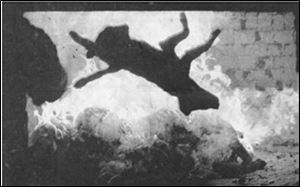
Skeldon's got to go
10/26/2009WHEN the committee formed to examine the Lucas County Dog Warden's policies and practices announced its first set of recommendations this week, Tom Skeldon's response was, "no comment." The county commissioners' retort should have been, "You're fired."

Nearly 80 percent of the dogs taken to the county pound are quickly euthanized and incinerated as shown in this 1994 prize-winning photograph.
Inmates of World War II concentration camps had a better chance of surviving than animals that end up in Mr. Skeldon's Doggie Dachau, where the nearly 80 percent euthanization rate leads to the reasonable conclusion that the dog warden enjoys killing dogs.
Unlicensed dogs are guaranteed only three days on death row before they are executed, while licensed animals whose owners can't be found are graciously allowed a 14-day reprieve before they are terminated.
In addition, fewer than 20 percent of the dogs seized by or surrendered to the warden are ever reclaimed. Even accounting for abandoned animals, that appalling return rate says Mr. Skeldon should be doing more to reunite dogs with their owners.
Many dog pounds elsewhere vaccinate animals as soon as they arrive; Mr. Skeldon only vaccinates those that survive the probationary period, effectively putting every animal in the facility at greater risk of disease. Other pounds also make wide use of rescue groups, but Mr. Skeldon has a magisterial policy of excluding all-breed rescue organizations other than the Toledo Area Humane Society, effectively condemning most animals to death.
Some of these deaths almost certainly were pets who strayed, say, when a family went on vacation and a caregiver opened the wrong door and inadvertently let the animal loose.
Some animals have to be put down because of illness or because past abuse has left irreparable psychological scars, but Mr. Skeldon's operation illustrates a more fundamental problem. The picture that emerged from the committee's recommendations was of a dog pound that is a killing machine, run by an official who has ruled his little fiefdom so long he has become both dictatorial and callous.
The people of Lucas County want a dog warden who is sensitive to life, one who remembers that the animals in his care often are the innocent victims of abusive or neglectful owners. Mr. Skeldon, who got his job mainly because of old family ties, loves the law better than animals, and has a prejudice against pit bull breeds so entrenched he even kills puppies far too young to be considered vicious.
Indeed, he is at the extreme end of the spectrum of people who deal with unwanted animals in our society. The view rapidly gaining credence is the one that advocates comprehensive spaying and neutering and placing animals in no-kill shelters until they can be adopted into loving homes. Mr. Skeldon is on the side that claims animals are being done a favor by being put to death. That view is both insensitive and wrong.
As we said, given the overwhelming scope of the problem, it is inevitable that some animals will have to be euthanized, but no dog that clearly has an owner should be destroyed just to satisfy the dog warden's apparent thirst for an ever-higher kill rate.
We feared that the committee, formed late last year by the county commissioners (one of whom, Tina Skeldon Wozniak, is Mr. Skeldon's cousin), would do no more than ratify existing policies. The fact that it issued such a critical report, and has promised even more far-reaching recommendations for change, is damning.
The report makes clear that for the benefit of the animals, systemic changes are needed in the dog warden's office. Mr. Skeldon's self-imposed muzzle after the presentation was a clear indication that he's not about to learn any new tricks.
If Mr. Skeldon is not replaced, the county commissioners, especially Ms. Wozniak, will be guilty of colluding in the wanton destruction of animals whose only crime is to have been man's best friend.
We'll be watching closely to see what they do.
In 1994, we first published the photograph that accompanies this editorial not to shock but in the hope that its grim reality would prompt a solution to what was already a serious problem. Fifteen years later, sad to say, unnecessary killing still goes on down at the county dog pound.